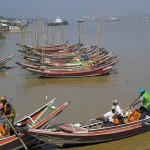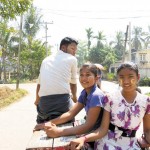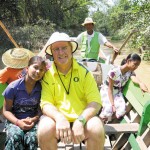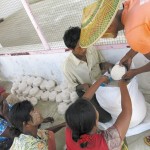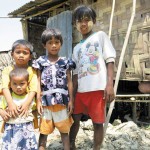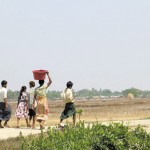Myanmar Boat Ride Turns Into More
It is a country with two names, one historically familiar, the other not so much. It’s home to 135 different ethnic groups, some currently in a “peace process” with the government. Centuries of foreign sailors along its 400-mile coastline and traders along its timeless overland trails leading to five modern nations have left their genes behind in the mix as well. It’s a country where the “road to Mandalay” actually is a river, the mighty Irrawaddy, in Kipling’s words “where the flyin’ fishes play.” In the past 150 years it has been a kingdom, a British colony later occupied by Japan in World War II, and an independent country again that would be taken over in a coup by a military dictatorship whose generals over five decades were quite good at repressing and massacring their own people by the thousands but so bad at administering an economy that since 2011 they’re opening up the country and giving way to a democratic parliament – and tourism. It may be the only place on Earth where Buddhists attack and kill Muslims. It is a country with two currencies, the local kyat (pronounced chat) and the preferred U.S. dollar – crisp, clean, unmarked and unfolded bills only, and your plastic and traveler’s checks are probably not going to be accepted most places. Cars proceed on the right side of the road, but drivers steer from the right side of the vehicle. The time difference from Honolulu, by the way, is seven and a half hours.
- Christina (left) and Nandamin selling postcards outside The Strand Hotel in Yangon. Don Chapman photos
- Rickshaw driver Jeskoo with Nandamin and Christina. Don Chapman photos
This is Myanmar, formerly known as Burma. It is a different place, and as foreign a country as has ever stamped my passport.
I was there for a 10-day stay that included the East-West Center-sponsored International Media Conference in Yangon – attended by more than 400 people from 31 countries. In this and two coming issues I’ll share some of those travels and insights.
To begin, a quite personal tale.
It started, as planned, on a warm Friday evening in Yangon, formerly Rangoon, a city of 4.5 million. I’d arrived earlier that day after a connecting flight from Taipei. Thanks to an e-mailed tip from the head of the Yangon chapter of InterNations, an international ex-pats club, I headed to the Yangon Sailing Club on massive Lake Inya for chilled beverages at sunset. The club, dating to British colonial times, is open to non-members Friday evenings and is popular with ex-pats of all sorts. A Brit working for a Middle Eastern telecom firm recommended several places worth visiting. All sounded nice, but what I really wanted to do on my one full day before the conference was go for a boat ride on the mighty, historic Yangon River. She suggested checking with the front desk of The Strand Hotel across from the wharf. I did just that Saturday morning, walked out of The Strand and my plans – and life, apparently – changed forever.
Outside, I was approached by a pair of street girls, 14 and 15, selling postcards. I bought 20. We chatted a bit, and I was impressed with their English skills, intelligence and personalities, and soon they offered to be my tour guides for the day. Their faces, by the way, were streaked with thanaka, a paste made from ground tree branches, and used by most women and some men, as much sunscreen as facial decoration. The younger girl, Nandamin, boasted, “I know all of Yangon – everything.”
(Picture a female Artful Dodger from Oliver, minus the pick-pocket skills.) Turns out she lost both parents in Cyclone Nargis in 2008 that killed 138,000, though it’s said the generals either quit counting after that or refused to name a higher figure (and then initially refused aid offered by President George W. Bush, adding to the tragedy). The elder girl, who goes by Christina, lost her father.
- Up a jungle river
- Measuring rice for residents of Dala village
- Village kids
- The busy, brown Yangon River
I said I wanted a boat ride on the river.
“OK,” Nandamin said, “we’ll show you the other side of the river. That’s where we live.”
Soon we were boarding a double-decker ferry.
Yangon is a major international port, and the busy, brown river teemed with cargo vessels and small, colorful motor launches, with gulls swooping all about. On the other side, in a chaotic, dusty parking area with trucks, taxis, bicycle rickshaws and women carrying produce in baskets atop their heads, the girls seemed to know everyone, and found two boys, Jeskoo and Lin Lin, 20 and 19, who pedaled rickshaws. Away we went, the girls on one and yers truly on the other.
Down leafy, wooded lanes, we passed houses without electricity or running water, homes doubling as small convenience stores, cafes or lumber yards. Skinny poi dogs slumbered on the side of the road or licked the insides of a cookie wrapper, looking for a taste of anything. We stopped at what they called the Blue and Gold Pagoda, a spartan Buddhist site, walked around and took turns ringing a big bell.
Back on the rickshaws – my guides full of the non-stop banter you might expect of siblings, which in many ways these parentless street teens are – they took me down to a muddy jungle river. There I hired a boatman with a wooden motor canoe to take us up the river past fishing villages built on stilts, hearing the calls of colorful birds in the trees. It was definitely one of those “I don’t think we’re in Kansas any more, Toto” kind of moments. I thought of friends who served in Vietnam, and how similar the terrain but so different an experience this was.
Back to the rickshaws, past the occasional chicken or goat, across a field where oxen grazed on the remnants of a recently harvested field of something like hay that was now collected into big rounded stacks, my teen guides took me to the worst and saddest place I have ever been. And they did it on purpose. The area is called Dala, perhaps Yangon’s poorest.
It was a village of about 100 huts, hovels really, constructed of wood sticks and bamboo, the stray brick or cinder block, or plastic sheet or strip of corrugated metal, whatever could be gathered, no doors in doorways, no glass or screens in windows, all connected by muddy, rocky paths. And most of the residents were young children. There were a few women, a few teens, very few men. One drew water from a greenish pond in two buckets, which he carried back to the village on either end of a wooden pole pressing on his shoulder. Residents often go days without food, I was told.
“Why,” I asked, the gentle reverie of my day suddenly shot to smithereens, “did you bring me here?”
“Would you like,” the rickshaw driver Jeskoo replied, “to buy them rice?”
We had not seen a market all day. “How would I do that?”
“Come,” he said, and it was back onto the rickshaws. A half mile later, across a wooden plank that served as bridge over a muddy ditch, was a nice home from which a couple sold rice. Offered handfuls of two grades, it was obvious which was superior. I bought two bags, about 55 pounds total, and we piled them aboard the rickshaws.
Back at the village, in the shade of the humblest Buddhist shrine in Myanmar, a few ladies of the village and a couple of teen boys, along with Nandamin, Christina, Jeskoo and Lin Lin, using a small metal bowl and a blue stick to level each measurement, poured rice into 100 clear plastic bags and tied them up, as children politely swarmed about.
“OK,” I said, “now what?” “Now,” my guides said, “you have to deliver it.”
With two teen boys from the village hauling the plastic bags in a big laundry basket, we went door to door, offering one bag of rice per hut, a boy of about 3 holding my hand.
Normally a germophobe, I held his hand. For one night, at least, the village would eat. I think of them, all of them, every day.
This story has a couple of kickers.
On the ferry, I was approached out of the blue by a gentleman originally from Korea. A Baptist minister, he’s been in Myamnar for 30 years and has established many churches, ordained many pastors. He mentioned he has a school.
“You have a school? There’s two girls you have to meet!”
Nandamin and Christina and I explained that they have had some schooling but can’t afford to attend school now, so work on the streets. Unfortunately, we learned, the pastor’s school is about a two-hour journey across Yangon and it’s ferocious traffic, too far from the girls’ homes. But they want to attend their neighborhood public school and make a better life for themselves.
So one week later, after the conference and a twoday foray to Bagan, I met the girls again at The Strand with Jeskoo and Nandamin’s unemployed, uneducated auntie. Over lunch at Junior Duck on the waterfront, I agreed to pay for the girls’ schooling for the next year. It is not that much in my scheme of things, a couple of hundred bucks apiece – $100 for school, $100 for uniform and supplies – but otherwise unobtainable in theirs. They are ecstatic, and promised to study well. They understand that education is power, and a path off the streets. Assuming they follow through, I promised to visit again next year to check on their progress. I am now “Grandpa Don.”
“I will be much taller then,” Nandamin said.
And even smarter too. And we’ll buy more rice for Dala.
I mention this story not as a public self-congratulatory, but as an example of a different kind of tourism. And what can happen when you just want to go for a boat ride.
Kicker two: I spent two days in Bagan among the ancient pagodas. In the lobby of my hotel, I met a woman from Washington state, Mary, who noted my U of Oregon logo shirt. And I told her my story about Nandamin and Christina. She had a story too. In Phukett, Thailand, 17 years ago she and her husband bought food at a street cart and chatted with the woman vendor. Returning several times over the years, they got to know her and her family. When the woman’s daughter finished high school she was unable to afford university, so the couple along with folks from their home town paid for the girl’s schooling. She graduated with an emphasis in business. Today, the family runs four food carts and a restaurant, with more growth in store.
I told Mary thank you, and that I would be using her story as a postscript for a column.
“By the way,” she said, “we know a family in the newspaper business in Oregon.”
“Where?” “Astoria and Pendleton.” “The Forresters! Mike Forrester gave me my first newspaper job out of U of O, in Pendleton!”
“We see him and his wife every year.”
It was that kind of trip.
More to come.
dchapman@midweek.com


